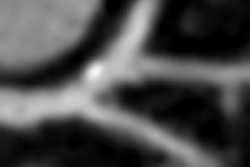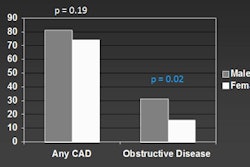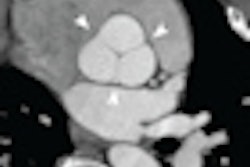Contrary to some previous studies, high-pitch, dual-source coronary CT angiography (CCTA) scans should be reserved for patients with the slowest heart rates, according to a new study published in the December issue of Radiology.
In the race to keep reducing CCTA doses, high-pitch scanning on dual-source CT scanners has emerged as an ultrafast technique that virtually eliminates motion artifacts while minimizing dose. But its use is limited if image quality is to be maintained.
In the clinical study, which looked at heart rates, image quality, and dose in various dual-source CTA protocols, Dutch researchers found that high-pitch protocols should be reserved for patients with heart rates 55 beats per minute (bpm) or slower -- with everyone else directed to a sequential scan technique.
"A high-pitch spiral CT coronary angiographic scan protocol offers a significant reduction in radiation dose compared with a narrow-window sequential scan protocol," wrote Dr. Lisan Neefjes and colleagues from Erasmus Medical Center. "However, in our study, image quality is maintained only in a selected patient population with a very low (< 55 beats per minute) heart rate" (Radiology, December 2011, Vol. 261:3, pp. 779-786).
The challenge when choosing a protocol for CCTA is getting the best image quality for the radiation dose, considering the heart rate, systolic or diastolic phase acquisition, and scan time, they wrote. Other image-degrading artifacts aren't protocol-specific, including blooming artifacts.
A second-generation dual-source CT scanner (Somatom Definition Flash, Siemens Healthcare) can be used to acquire low-dose coronary CTA images with two categories of protocols. Prospective electrocardiogram (ECG)-triggered sequential scans can be acquired in patients with heart rates faster than 65 bpm with a high temporal resolution of 75 msec. Newer on the scene is an even lower-dose option: a high-pitch protocol that allows ultrafast scans (approximately 270 msec) using less than 1 mSv of radiation.
"However, the feasibility and effect on both image quality and radiation exposure in a large patient population with various heart rates by using these low-dose scan modes is currently unknown," the authors wrote. In particular, the performance of high-pitch scans in a large patient population with different heart rates hasn't been explored. Therefore, the study aimed to compare image quality, radiation dose, and their relationship with a range of heart rates, according to Neefjes and colleagues.
The investigators placed the cohort of 272 patients referred for coronary CTA (175 men, 97 women; mean ages, 58 and 59 years, respectively) into two groups according to heart rate: those with heart rates slower than 65 bpm (group A) and those with heart rates at 65 bpm or faster (group B).
Patients were randomly selected to undergo prospective high-pitch spiral scanning and narrow-window prospective sequential scanning in group A (n = 160) or wide-window prospective sequential scanning and retrospective spiral scanning in group B (n = 112). Image quality was graded on a scale (1 = nondiagnostic images, 2 = diagnostic with artifacts, 3 = no artifacts) and compared using Mann-Whitney and Student's t-tests.
Patients with arrhythmias, contraindications to iodinated contrast, or a history of coronary interventions were excluded. Those with heart rates faster than 65 bpm received a single dose of metoprolol, while all patients were given sublingual nitroglycerin before the scan. Patients received a single bolus of iodinated contrast medium (Ultravist, Bayer HealthCare Pharmaceuticals) with volume adapted to the scan protocol: 75 mL for high-pitch spiral CT, and 100 mL for sequential scans. Data were reconstructed with a slice thickness of 0.75 mm, a 0.4-mm increment, and a field-of view of 180 mm.
The results showed that high-pitch spiral CCTA delivered a significant reduction in radiation dose compared with a narrow-window sequential scan. However, the applicability of high-pitch scans is limited.
"In our study, image quality is maintained only in a selected patient population with a very low (< 55 beats per minute) heart rate," Neefjes and colleagues wrote. "A wide-window sequential scan protocol offers a significant reduction in radiation dose compared with a retrospective spiral scan protocol and provides similar image quality."
Results were as follows:
- In group A patients (slower heart rates), mean image quality was significantly lower using high-pitch spiral versus sequential scanning (2.67 ± 0.38 versus 2.86 ± 0.21; p < 0.001). For the subpopulation in group A with heart rates slower than 55 bpm, the mean image quality grade was similar for spiral (2.81 ± 0.30) and sequential (2.94 ± 0.08; p = 0.35) protocols.
- In group B patients (faster heart rates), image quality was comparable between sequential (2.81 ± 0.28) and retrospective spiral (2.80 ± 0.38; p = 0.54) scans.
- In group A, the estimated radiation dose was significantly lower using high-pitch spiral versus sequential scanning for both 100 kV (0.81 mSv ± 0.30 for high pitch; 2.74 mSv ± 1.14 for sequential; p < 0.001) and 120 kV settings (1.65 mSv ± 0.69 for high pitch; 4.21 mSv ± 1.20 for sequential; p < 0.001).
- In group B, the radiation dose was significantly lower using sequential versus retrospective spiral scanning for both 100 kV (4.07 mSv ± 1.07 for sequential; 5.54 mSv ± 1.76 for retrospective; p = 0.02) and 120 kV (7.50 mSv ± 1.79 for sequential; 9.83 mSv ± 3.49 for retrospective; p = 0.1).
"We randomized between a high-pitch spiral and a sequential (with a narrow diastolic scan window) scan protocol in patients with a heart rate of 65 beats per minute or less, because the feasibility and effectiveness of the sequential scanning protocol is well validated and is currently considered as the standard scan mode in this patient population," they wrote.
The good image quality of the high-pitch scan for patients with heart rates slower than 55 bpm was in line with the results of smaller studies, they noted. "However, we found a lower overall image quality by using a high-pitch spiral scan protocol compared with a narrow-window sequential scan protocol in patients with heart rates of 55 beats per minute or greater," a result that contradicted previous studies in which researchers reported similar image quality in patients with a heart rate up to 70 bpm.
More aggressive use of beta-blockers in younger patients may permit high-pitch scanning in more patients, Neefjes and colleagues wrote.
Based on the results, the authors suggested the following dual-source CCTA protocols:
- A high-pitch spiral scan protocol in patients with a heart rate slower than 55 beats per minute
- A sequential scan protocol with a narrow scan window in patients with a heart rate between 55 and 65 beats per minute
- A sequential scan protocol with a wide scan window in patients with a heart rate faster than 65 beats per minute
Those protocols would yield mean estimated radiation doses of 2.9 mSv in group A and 6.0 mSv in group B, the group concluded.




















